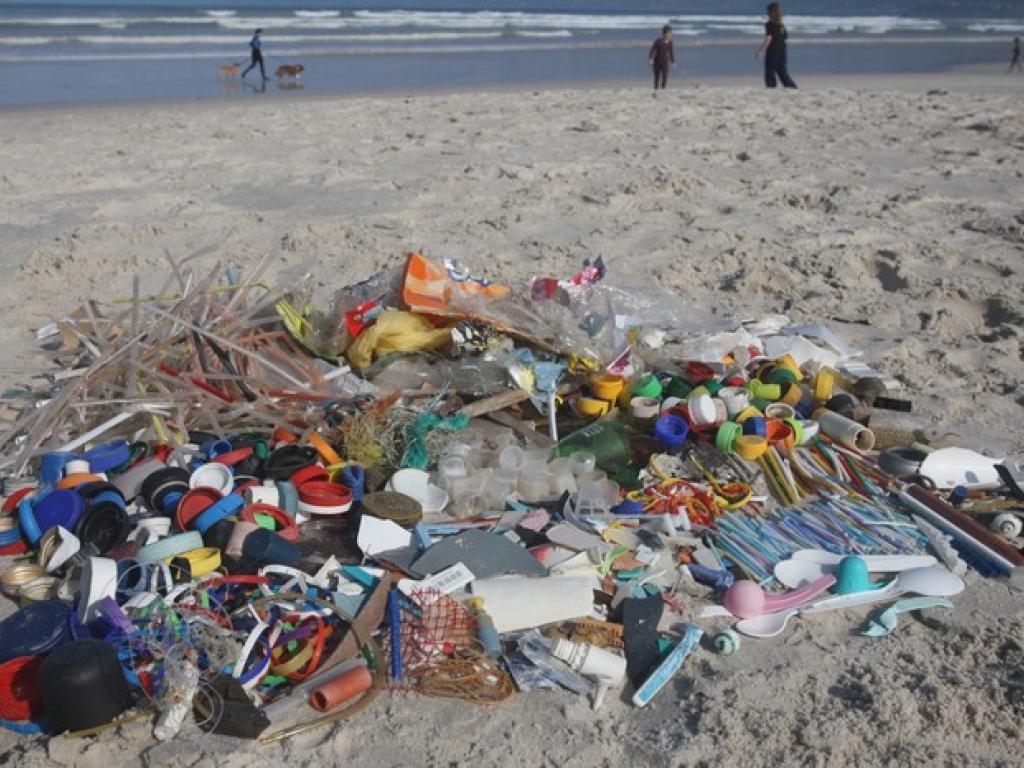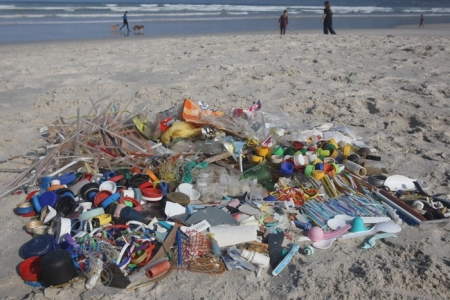Five applications where plastic is not fantastic


Despite being cleaned daily, Eastern Beach, East London, has the dubious claim of being South Africa's dirtiest beach – this collection of litter made in 2010 comes from just 12m of beach.
Two of the key properties of plastics that make them so central to our modern lives are their light weight and durability. This also makes them global pollutants when they are not disposed of correctly. South Africa fares particularly badly. A recent paper estimated that South Africa was the world’s 11th worst offender when it comes to releasing plastic wastes into the sea.
South Africa even comes in ahead of heavyweight polluter India. This is due to a combination of two factors. A high per capita consumption of plastics – estimated at 2 kg per person per day, almost as much as the US – and a high proportion of solid waste not entering a formal disposal scheme, for example, being reused, recycled or at least disposed of safely in a long-term landfill site. An astonishing 56% of plastic waste ends up littering the environment in South Africa, compared to 11% in Brazil or 2% in the US.
Effective solutions are needed to stem the flood of waste plastic. These include creating greater awareness among consumers and providing incentives to promote reuse or recycling. One effective intervention would be to stop making some litter-prone items from plastic. Among the top offenders are: ear buds, bottle lids, plastic straws, individual sweet wrappers and expanded polystyrene food packaging. There are ready alternatives for some and clever design could do away with the rest.
Marine pollution
Anything between 5 and 12 million tonnes of waste plastics enter the sea each year. Much of this floats and, given its very long lifespan in the sea, disperses across the planet. Floating litter accumulates in the centre of each ocean basin, where it is eaten by all manner of marine life including turtles, whales, seabirds and fish.
There is particular concern about the impact of microplastics on marine foodwebs because of their ubiquitous nature and potential to carry toxic substances. Microplastics are tiny pieces of plastic, ranging from a few microns to a few millimetres across that form when larger plastics are broken down by UV light.
When they drift at sea, plastic particles accumulate a cocktail of potentially toxic compounds that are released when consumed by marine organisms, affecting their predators, including humans. And denser plastic items sink to the seabed, where they block gas exchange, promoting the formation of anoxic sediments, devoid of oxygen, with severe implications for animals that live on the seabed.
Most marine litter is plastic packaging – single use applications that are particularly prone to inappropriate disposal.
Our survey of beach litter around South Africa in 2015, supported by Plastics SA, an industry sponsored body, found that 94% of litter on South African beaches is made of plastic. 77% of this is packaging. And the situation is not improving. The amount of litter washing up daily in Cape Town’s Table Bay tripled from 1994 to 2011, far outstripping human population growth over this period.
Some solutions
Waste plastic has value. It can be recycled, burned to generate electricity or used to make fuel. The challenge is to establish efficient ways of harnessing that value. Appropriate incentives are needed to promote reuse and recycling.
The pricing of consumer products ignores their environmental costs – which in the case of plastic litter runs to hundreds of millions of rands annually just keeping South African beaches clean.
In Australia and the US, for example, much higher proportions of plastic bottles that carry a nominal refund are recycled, compared to those that don’t. And getting people involved in recycling initiativeshas wider environmental benefits.
Product substitution is another possibility. Although plastics are in fact the best product for the job - in terms of economic and environmental costs - for most applications, packaging design could be changed. Many packaging items are virtually impossible to recycle because they are made from multiple materials.
Replacing plastics may be warranted in some particularly high-risk products. Five applications that would be better served if they were not made from plastic include:
1. Earbuds: until the 1980s, earbud sticks were made from rolled wax paper. The switch to plastic sticks saw a massive increase in their abundance on South African beaches. They have been found to carry tiny goose barnacles at Tristan da Cunha, 2800 km west of Cape Town. Reverting to waxed paper would solve this problem.
2. Drinking straws: they are among the most ubiquitous litter items on South African beaches. East London’s Eastern Beach has an average of 44 straws per metre of beach, despite being cleaned daily. Straws could either be phased out or replaced with waxed paper straws.
3. Bottle lids: one of the fastest growing litter types. Sports drinks with push-pull spigots use more plastic than conventional lids and the clear plastic covers are particularly prone to littering. The phasing out of ring pull-tabs on drink cans had a marked impact on this type of litter. Sports drink caps require a similar redesign solution. Or they should be phased out.
4. Individual sweet wrappers are another super-abundant litter item. There is no reason why sweets sold in packets require individual wrappers.
5. Expanded polystyrene food packaging is widely used in the fast food industry. Fragments of polystyrene cups and trays are among the most ubiquitous forms of litter on beaches with an average density of 3 pieces per metre and peak values on urban beaches of up to 30 pieces per metre. This is despite every increasing efforts to clean up beaches.
Of course, the problem lies not only with the plastics but also with plastic users' behaviour. Education is a priority. But education alone will not solve the problem. A multifaceted approach that uses direct incentives, legislation and education to change behaviour is needed. Charging for shopping bags greatly reduced the number of bags littering South Africa. Similar initiatives to reduce other highly litter-prone products are needed.
By Peter Ryan, Director, FitzPatrick Institute of African Ornithology, and Coleen Moloney, Associate Professor Ecological modelling, University of Cape Town.
This article first appeared in The Conversation, a collaboration between editors and academics to provide informed news analysis and commentary. Its content is free to read and republish under Creative Commons; media who would like to republish this article should do so directly from its appearance on The Conversation, using the button in the right-hand column of the webpage. UCT academics who would like to write for The Conversation should register with them; you are also welcome to find out more from carolyn.newton@uct.ac.za.